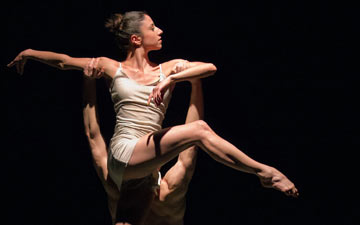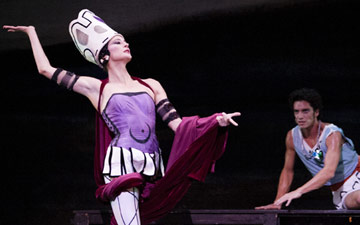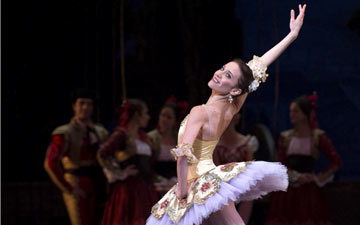
© Noureev & Friends. (Click image for larger version)
Noureev & Friends Gala
Paris, Palais Des Congrès
31 May 2013
www.nureyev.org
noureevandfriends.com
Tributes from across the globe have been showered upon the late Rudolf Nureyev during 2013, a year which represents two significant milestones – both the 75th Anniversary of his birth and 20 years since his death; a duality that simply reminds us how tragically brief was his tumultuous life. At the end of July, English National Ballet (ENB) presents a triple bill at the London Coliseum in tribute to Nureyev, comprising Petrushka, Maurice Béjart’s Song of A Wayfarer and the third Act of Raymonda (which was also presented earlier in the year by The Royal Ballet). There has been a major Nureyev exhibition in San Francisco and special performances around the world from the Sydney Opera House to La Scala in Milan.
We may have the Fonteyn connection in London but it was Paris – more than any other city – that held Nureyev’s presence in his adult life. It was at Le Bourget Airport – during the Kirov Ballet’s debut tour, in 1961 – that Nureyev took the momentous decision to appeal for political asylum; it was the Paris Opera Ballet that he directed (from 1983 to 1989); and it is the city in which he died and near to which his remains are buried. A special gala performance commemorating his life was mounted by the Paris Opera Ballet on 6 March but the French capital got a second bite at the cherry with this gala event, organised over two nights by D&D Productions and directed jointly by Charles Jude (artistic director of the Bordeaux Opera Ballet) and former Royal Ballet principal, David Makhateli. For 12 years (between 1980 and 1992) Jude was part of an itinerant band of dancers known as “Nureyev & Friends”, from whence no doubt this gala takes its odd, bilingual title: Noureev being the French form of his name. It could just as easily have been “Nureyev et amis”?
Jude stamped his mark on the programme from the off with his Bordeaux company dancing the whole of Jirí Kylián’s Petite Mort as the opening number. It is rare to have such a large and complete work in a gala and it started the event with an unusual degree of substance. But, I have no notion of how this ballet relates to Nureyev. Kylián was active as a choreographer for the last 20 years’ of Nureyev’s life but without any significant association between them, and Nureyev never performed in a work by the Czech choreographer. On the other hand, he performed in six works by Rudi van Dantzig and eight by Martha Graham, neither of whom was represented in the gala. So, was this to be a gala in which the relevance of work to the life being commemorated was, at best, coincidental?
Noureev & Friends promotional video
Having seen ENB premiere Petite Mort, a few months earlier, here was an immediate comparison and I must acknowledge that the 12 Bordeaux dancers appeared to struggle with the crisp precision required and a dance floor that didn’t seem to do them any favours. There needs to be tight harmony in the six couples and in the synchronicity of the men playing with fencing foils and it was not always evident. Nonetheless, it was a fun, unusual and interesting opener.
There followed a long series of pas de deux through the ages, spanning 160 years in their composition, as well as straddling the interval. Marian Walter and Iana Salenko of the Berlin Opera Ballet gave a charming account of the main pas de deux from August Bournonville’s La Sylphide; the Bolshoi’s Evgenia Obraztsova was delightful as Nikiya in the second act pas de deux from La Bayadère, strongly partnered by Evgeni Ivanchenko of the Mariinsky Ballet; Tamara Rojo showed her command of character by capturing the expressiveness and passion of Manon in the bedroom pas de deux even when shorn of the back story, and she was effectively partnered by The Royal Ballet’s Federico Bonelli; the imposing duo of Paris Opera Ballet’s Aurélie Dupont and Mathias Heymann romped through Nureyev’s own interpretation of Petipa’s choreography in the wedding scene from Raymonda; and there was a stimulating return for Obraztsova in The Sleeping Beauty pas de deux, this time with her colleague from the Bolshoi, Dmitry Gudanov.
These five duets were excellent interpretations of standard gala fare, each of which had a direct association with Nureyev who danced all five of the male roles (James – La Sylphide; Solor – La Bayadère; Des Grieux – Manon; Jean de Brienne – Raymonda; and Prince Désiré – The Sleeping Beauty). Each of these was a role that meant something significant in his career.
The sixth, however, was quite different as Maia Makhateli and Remi Wörtmeyer of Het Nationale Ballet gave a scintillating and passionate account of Two Pieces for Het by Hans Van Manen. Adding frisson to this performance was the presence of the Dutch Master himself, both in an onscreen interview and in person. I reckon that Nureyev danced in 11 works by the trio of great Dutch choreographers (van Manen, van Dantzig and Toer van Schayk) and so it was important for this key Nederlands element of Nureyev’s career to be represented, although the work chosen came after his death. Nonetheless, the performance was an unexpected highlight of the evening and Makhateli was sensational, possessing feet as pliable as a pair of carpet slippers.
Nureyev as choreographer was presented in the form of Heymann’s solo from Manfred, which emerged from Nureyev’s obsession about the adventurous poet Byron, which he brings to life through Tchaikovsky’s eponymous symphony and very much influenced by the choreographic style of Glen Tetley and Paul Taylor. Nureyev was unable to dance in the premiere of his own ballet, due to injury, and Heymann himself has suffered a long period of absence from the stage. In this way, we had a sense of the special exuberance that Nureyev must have brought to this most personal of roles when he finally got to perform it in December 1979. Heymann again reminded us of his prodigious talent by tearing up the stage in a coruscating cameo.
On either side of a pedestrian White Swan adagio, danced by Daria Vasnetsova and Ivanchenko, came very strong performances at the end. Firstly, Rojo reprised her intense grasp of emotional control and dramatic tension as the doomed Marguerite in a large slice of Ashton’s Marguerite & Armand, alongside Rupert Pennefather in the other title role (supported by an uncredited James Streeter). I was told that the equally uncredited pianist (who I can name as Olga Jegunova) that played the Liszt piano sonata had not performed for ballet before and if that is so, it was a mighty fine first attempt. At the dress rehearsal, she struggled with the dance tempo but it was certainly alright on the night!
An explosive conclusion to the event came in the powerful grand pas de deux from Le Corsaire, given by ENB’s Vadim Muntagirov – just a few days prior to receiving his Benois de la Danse award in Russia – and the Moscow Kremlin Ballet’s Alexandra Timofeeva, whose impeccable technique appears to have no weakness. She jumps strongly, pirouettes on the perpendicular, equally well at any speed, has strong, supple feet, wonderful arms and hands and always presents in the right line and balance. It was a strong end to a well-paced programme, which was interjected by some snippets of film, the best of which was a very warm and revealing interview with Mikhail Baryshnikov.
A major plus for this over many similar galas was the presence of an orchestra and the Orchestre Pasdeloup performed more than satisfactorily under the direction of Valery Ovsianikov. Often there is no set design at such events but here there was an innovative approach with moving digital film backdrops, portraying relevant scenes, such as water gently lapping against the lakeside for the White Swan pas de deux. During the dress rehearsal, I thought that these might look like the moving waterfall pictures often seen in a Chinese restaurant but in fact they were very effective substitutions for the lack of any set.
At the end the “& Friends” tag was rewarded by a long line of dignitaries – in fact, I think anyone who ever knew Nureyev in the audience – which ranged from luminaries of the dance world (Carla Fracci, van Manen and the Royal Ballet’s ballet master, Alexander Agadzhanov to name but three) to pop singers, critics and restaurant managers. Announced in French, I have no idea who most of the cast of hundreds were but I have a feeling that the man who clipped Nureyev’s nasal hair was in there somewhere. It was a tortuously long line and several people in the audience decided to leave before it was complete.
VIPs aside, as such events go, this was from the top drawer. The dancing was exemplary with several tremendous capsule performances: from Salenko’s ethereal sylph to Rojo’s consumptive courtesan. My only quibble is with the relevance and balance of the programme, which reflected the ballet bias of the organisers. Nureyev appeared in ten works by the combined group of Glen Tetley, Paul Taylor and Murray Louis and a further eight by Martha Graham but there was no room for an example of this telling side of his repertoire. Perhaps, even more conspicuously absent – given the host city – was anything by Roland Petit. Cullberg, Flindt and Béjart were other notable absentees and it would have been far more balanced to have dropped at least one Petipa pas de deux for a modern work. But, for so many, Rudolf Nureyev = ballet even if in the last 20 years of his life most of his own performances were in the contemporary genre. C’est La Vie!
Author’s note: my notes on this gala were recorded contemporaneously (1 June) but due to a bereavement of a close member of my family I have only now (19 July) been able to write them up into a review.

















You must be logged in to post a comment.